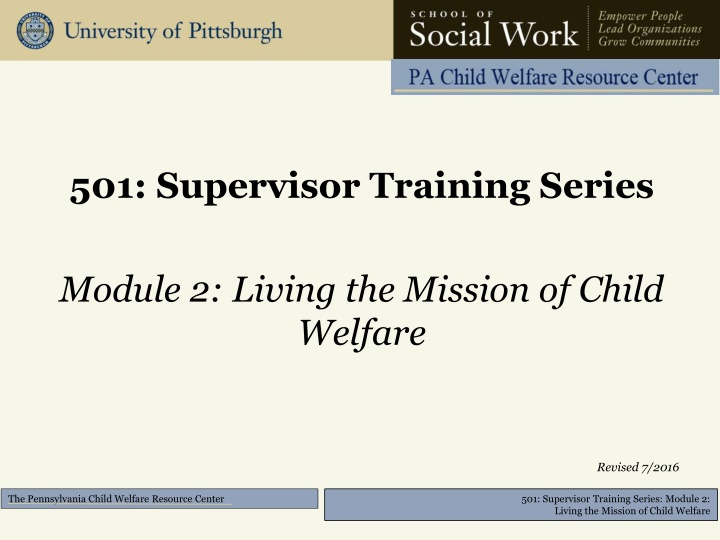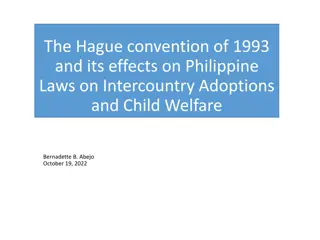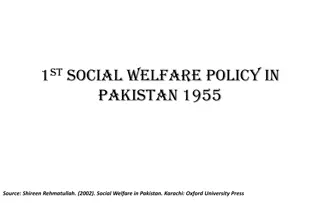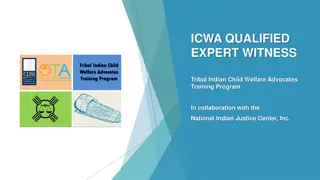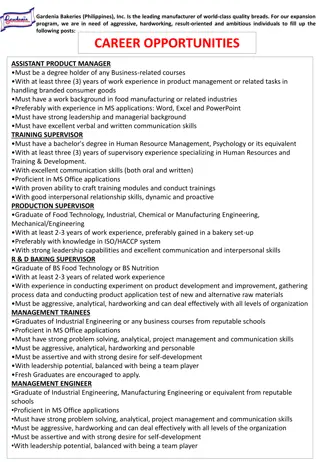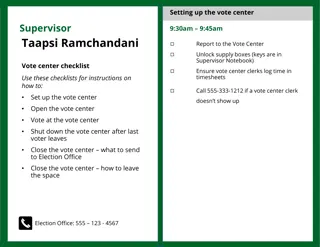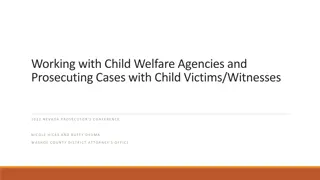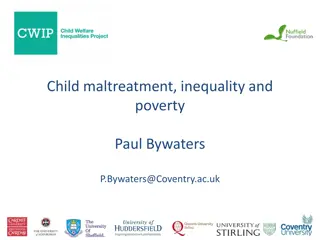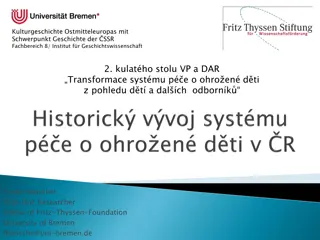Supervisor Training Series: Living the Mission of Child Welfare
This supervisor training series focuses on defining organizational mission and outcomes consistent with child welfare laws, exploring an open system model, implementing continuous quality improvement, assessing work activities, planning for change, and achieving identified outcomes. Participants will learn valuable skills to enhance child welfare practices.
Download Presentation

Please find below an Image/Link to download the presentation.
The content on the website is provided AS IS for your information and personal use only. It may not be sold, licensed, or shared on other websites without obtaining consent from the author.If you encounter any issues during the download, it is possible that the publisher has removed the file from their server.
You are allowed to download the files provided on this website for personal or commercial use, subject to the condition that they are used lawfully. All files are the property of their respective owners.
The content on the website is provided AS IS for your information and personal use only. It may not be sold, licensed, or shared on other websites without obtaining consent from the author.
E N D
Presentation Transcript
501: Supervisor Training Series Module 2: Living the Mission of Child Welfare Revised 7/2016 501: Supervisor Training Series: Module 2: Living the Mission of Child Welfare The Pennsylvania Child Welfare Resource Center
The Supervisor Training Series Module 1: The Preparatory and Beginning Phases of Child Welfare Supervision Module 2: Living the Mission of Child Welfare Module 3: The Middle/Work Phase of Supervision Module 4: Managing Diversity through the Employment Process Module 5: Endings and Transitions/Managing Staff Retention, Satisfaction, and Separation 501: Supervisor Training Series: Module 2: Living the Mission of Child Welfare The Pennsylvania Child Welfare Resource Center 2
Agenda Day One Introduction Child Welfare Vision, Mission, Values, and Practice Model Child Welfare as an Open System Continuous Quality Improvement (CQI) Defining Key Outcomes in Serving Families Identifying Benchmarks and Indicators 501: Supervisor Training Series: Module 2: Living the Mission of Child Welfare The Pennsylvania Child Welfare Resource Center 3
Agenda Day Two Performance Actions and Performance Capacity Assessing for Change Planning for Change Implementing the Change Process Monitoring Progress Transferring Skills to Practice Evaluation and Closure 501: Supervisor Training Series: Module 2: Living the Mission of Child Welfare The Pennsylvania Child Welfare Resource Center 4
Learning Objectives Participants will be able to: Define organizational mission and outcomes that are consistent with the Adoption and Safe Families Act and the Pennsylvania Child Welfare Practice Model; Identify the components of an Open System Model; Describe how Continuous Quality Improvement (CQI) can be achieved using the DAPIMTM framework; 501: Supervisor Training Series: Module 2: Living the Mission of Child Welfare The Pennsylvania Child Welfare Resource Center 5
Learning Objectives (continued) Participants will be able to: Explore ways to assess and plan work activities of the unit and staff member that will achieve identified outcomes; Explain how to implement necessary change within the unit; and Explore ways to monitor work activities to support the achievement of identified outcomes. 501: Supervisor Training Series: Module 2: Living the Mission of Child Welfare The Pennsylvania Child Welfare Resource Center 6
Roles of Supervision Administrative Supervision focuses on those areas of supervision related to the efficient and effective delivery of services. This module stresses the importance of understanding one s own management style within the context of the agency s mission and vision and administrative structure and focuses on agency goals and outcomes. It is within this role that the supervisor must always be aware of the supervisor role as an agent of the organization. It becomes the supervisor s responsibility to support cohesion among the department and collaboration between departments by leading through example. Educational Supervision Clinical Supervision 501: Supervisor Training Series: Module 2: Living the Mission of Child Welfare The Pennsylvania Child Welfare Resource Center 7
Idea Catcher Don t let a good idea get away! People remember: 20% of what they hear 30% of what they see 70% of what they say 90% of what they do 501: Supervisor Training Series: Module 2: Living the Mission of Child Welfare The Pennsylvania Child Welfare Resource Center 8
ASFA Provisions Ensure that child safety is the paramount concern in all child welfare decision-making Shorten the timeframes for making permanency planning decisions and promote the adoption of children who cannot safely return to their own homes Focus on the well-being of, and positive results for, children and families and strengthen partnerships between child welfare agencies and other systems to support families at the community level Source: Rethinking Child Welfare Practice Under the Adoption and Safe Families Act of 1997:A Resource Guide, by the U. S. Department of Health and Human Services 501: Supervisor Training Series: Module 2: Living the Mission of Child Welfare The Pennsylvania Child Welfare Resource Center 9
On the Floor 501: Supervisor Training Series: Module 2: Living the Mission of Child Welfare The Pennsylvania Child Welfare Resource Center 10
Lets Get on the Balcony 501: Supervisor Training Series: Module 2: Living the Mission of Child Welfare The Pennsylvania Child Welfare Resource Center 11
Vision A vision statement describes how the future will look when an organization s desires and aspirations are realized. (American Public Human Services Association, 2011) 501: Supervisor Training Series: Module 2: Living the Mission of Child Welfare The Pennsylvania Child Welfare Resource Center 12
Pennsylvania Child Welfare Resource Center s Vision Every child, youth, and family experiences a life rich with positive opportunities, nurturing relationships, and supportive communities. 501: Supervisor Training Series: Module 2: Living the Mission of Child Welfare The Pennsylvania Child Welfare Resource Center 13
Mission A mission statement describes the particular role an organization plays in realizing that vision. The mission statement must have fit, clarity, and commitment. (American Public Human Services Association, 2011) 501: Supervisor Training Series: Module 2: Living the Mission of Child Welfare The Pennsylvania Child Welfare Resource Center 14
A Mission Must Have Fit Clarity Commitment 501: Supervisor Training Series: Module 2: Living the Mission of Child Welfare The Pennsylvania Child Welfare Resource Center 15
Effective Mission Statements are: Brief Broad Clear Compelling Memorable Real Cultural 501: Supervisor Training Series: Module 2: Living the Mission of Child Welfare The Pennsylvania Child Welfare Resource Center 16
Effective Mission Statements Tell: Who benefits; What will be done; How results will be produced; and Address the diversity of the population served. 501: Supervisor Training Series: Module 2: Living the Mission of Child Welfare The Pennsylvania Child Welfare Resource Center 17
Pennsylvania Child Welfare Resource Center s Mission Statement The Pennsylvania Child Welfare Resource Center is a national leader in advocating for an enhanced quality of life for Pennsylvania s children, youth, and families. In partnership with families, communities, public and private agencies, we prepare and support exceptional Child Welfare Professionals and systems through education, research and a commitment to best practice. 501: Supervisor Training Series: Module 2: Living the Mission of Child Welfare The Pennsylvania Child Welfare Resource Center 18
What is the Pennsylvanias Child Welfare Practice Model? Vision & Values Linking Ideals to Practice 501: Supervisor Training Series: Module 2: Living the Mission of Child Welfare The Pennsylvania Child Welfare Resource Center 19
Pennsylvanias Child Welfare Practice Model Outcomes Values and Principles Skills 501: Supervisor Training Series: Module 2: Living the Mission of Child Welfare The Pennsylvania Child Welfare Resource Center 20
Pennsylvanias Child Welfare Practice Model: Outcomes Safety from abuse and neglect Permanence Wellbeing Support through services Strengthened families Skilled and responsive child welfare professionals 501: Supervisor Training Series: Module 2: Living the Mission of Child Welfare The Pennsylvania Child Welfare Resource Center 21
Pennsylvanias Child Welfare Practice Model : Values and Principles Children, Youth, Families Community Honesty Cultural Awareness and Responsiveness Respect Teaming Organizational Excellence 501: Supervisor Training Series: Module 2: Living the Mission of Child Welfare The Pennsylvania Child Welfare Resource Center 22
Pennsylvanias Child Welfare Practice Model : Skills Engaging Teaming Assessing and Understanding Planning Implementing Monitoring and Adjusting 501: Supervisor Training Series: Module 2: Living the Mission of Child Welfare The Pennsylvania Child Welfare Resource Center 23
For More Information on Pennsylvanias Child Welfare Practice Model http://www.pacwrc.pitt.edu/PracticeModel.htm 501: Supervisor Training Series: Module 2: Living the Mission of Child Welfare The Pennsylvania Child Welfare Resource Center 24
What is a System? A group of interacting, interrelated, and interdependent components that form a complex and unified whole. (pegasus.com, 2011) 501: Supervisor Training Series: Module 2: Living the Mission of Child Welfare The Pennsylvania Child Welfare Resource Center 25
Characteristics of All Systems Every system has a purpose within a larger system; All of a system's parts must be present for the system to carry out its purpose optimally; A system's parts must be arranged in a specific way for the system to carry out its purpose; Systems change in response to feedback; and Systems maintain their stability by making adjustments based on feedback. (Pegasus.com, 2011) 501: Supervisor Training Series: Module 2: Living the Mission of Child Welfare The Pennsylvania Child Welfare Resource Center 26
501: Supervisor Training Series: Module 2: Living the Mission of Child Welfare The Pennsylvania Child Welfare Resource Center 27
Continuous Quality Improvement (CQI) The ongoing process by which an agency makes decisions and evaluates its progress. The National Resource Center for Organizational Improvement and Casey Family Programs 501: Supervisor Training Series: Module 2: Living the Mission of Child Welfare The Pennsylvania Child Welfare Resource Center 28
The Purpose of Continuous Quality Improvement (CQI) The purpose of CQI is to consistently gather information from a variety of sources that can help to evaluate the quality of services delivered, inform decision making related to program and agency improvements, and assist in the development of a plan for improvement. 501: Supervisor Training Series: Module 2: Living the Mission of Child Welfare The Pennsylvania Child Welfare Resource Center 29
What Does DAPIMMean? D: Define A: Assess P: Plan I: Implement M: Monitor 501: Supervisor Training Series: Module 2: Living the Mission of Child Welfare The Pennsylvania Child Welfare Resource Center 30
501: Supervisor Training Series: Module 2: Living the Mission of Child Welfare The Pennsylvania Child Welfare Resource Center 31
501: Supervisor Training Series: Module 2: Living the Mission of Child Welfare The Pennsylvania Child Welfare Resource Center 32
DAPIMTM (Define) Define the Desired Future State. What do you want to improve? If the problem were solved, what would you see in your agency? How would you define success? 501: Supervisor Training Series: Module 2: Living the Mission of Child Welfare The Pennsylvania Child Welfare Resource Center 33
DAPIMTM (Assess) Assess strategy, inputs (resources), performance capacity, performance activities, outputs, outcomes, and feedback from the environment. 501: Supervisor Training Series: Module 2: Living the Mission of Child Welfare The Pennsylvania Child Welfare Resource Center 34
DAPIMTM (Bridge to Planning) Bridging assessment and planning work involves group input, brainstorming, and dialogue to determine: Findings: Strengths and Gaps Priority Needs Root Causes General Remedies 501: Supervisor Training Series: Module 2: Living the Mission of Child Welfare The Pennsylvania Child Welfare Resource Center 35
DAPIMTM (Bridge to Planning) Why are work teams important? They create buy-in. Staff at all levels have a chance to participate in creating something that would have an impact on themselves and others. 501: Supervisor Training Series: Module 2: Living the Mission of Child Welfare The Pennsylvania Child Welfare Resource Center 36
DAPIMTM (Plan) Identifies both rapid (quick wins), mid term improvements, and long-term improvements; Involves the County Improvement Plan that drives the Needs Based Plan and Budget. Includes capacity planning; and Includes communication planning. 501: Supervisor Training Series: Module 2: Living the Mission of Child Welfare The Pennsylvania Child Welfare Resource Center 37
DAPIMTM (Implement) Implement those plans in detail. Work teams continue; Action plans; Capacity building turns into capacity management; and Communication management. 501: Supervisor Training Series: Module 2: Living the Mission of Child Welfare The Pennsylvania Child Welfare Resource Center 38
DAPIMTM (Monitor) Monitor progress and impact for accountability and ongoing adjustment. 501: Supervisor Training Series: Module 2: Living the Mission of Child Welfare The Pennsylvania Child Welfare Resource Center 39
DAPIMTM (Monitor) (continued) Monitoring completes the flywheel. Monitoring uncovers new areas for continuous improvement. The flywheel starts again resulting in Continuous Quality Improvement. 501: Supervisor Training Series: Module 2: Living the Mission of Child Welfare The Pennsylvania Child Welfare Resource Center 40
We must become the change we want to see Mahatma Ghandi 501: Supervisor Training Series: Module 2: Living the Mission of Child Welfare The Pennsylvania Child Welfare Resource Center 41
APHSA Logo 501: Supervisor Training Series: Module 2: Living the Mission of Child Welfare The Pennsylvania Child Welfare Resource Center 42
Define the Desired Future State What do you want to improve? If the problem were solved, what would you see in your agency? How would you define success? 501: Supervisor Training Series: Module 2: Living the Mission of Child Welfare The Pennsylvania Child Welfare Resource Center 43
Outcomes are: Mission-critical Specific Measurable Observable Behavior-oriented Results-oriented (rather than stating an output) 501: Supervisor Training Series: Module 2: Living the Mission of Child Welfare The Pennsylvania Child Welfare Resource Center 44
Benchmarks & Indicators Benchmarks and indicators helps us to measure progress toward mission-critical results. 501: Supervisor Training Series: Module 2: Living the Mission of Child Welfare The Pennsylvania Child Welfare Resource Center 45
Whats the Difference? Indicators describe what we are measuring to gauge performance or progress toward the outcome. Benchmarks are the measurements for which we aim that demonstrate that progress is being made toward the outcome. numbers increases decreases stability 3 out of 10 10% 5% 90% 501: Supervisor Training Series: Module 2: Living the Mission of Child Welfare The Pennsylvania Child Welfare Resource Center 46
Baseline 1st measurement of the indicator 501: Supervisor Training Series: Module 2: Living the Mission of Child Welfare The Pennsylvania Child Welfare Resource Center 47
Effective Benchmarks and Indicators are: Specific Observable Measurable Mission-Critical Culturally Competent Clear and Reasonable 501: Supervisor Training Series: Module 2: Living the Mission of Child Welfare The Pennsylvania Child Welfare Resource Center 48
Agenda Day One Introduction Child Welfare Vision, Mission, Values, and Practice Model Child Welfare As An Open System Continuous Quality Improvement (CQI) Defining Key Outcomes In Serving Families Identifying Benchmarks And Indicators 501: Supervisor Training Series: Module 2: Living the Mission of Child Welfare The Pennsylvania Child Welfare Resource Center 49
Agenda Day Two Performance Actions And Performance Capacity Assessing For Change Planning For Change Implementing The Change Process Monitoring Progress Transferring Skills To Practice Evaluation And Closure 501: Supervisor Training Series: Module 2: Living the Mission of Child Welfare The Pennsylvania Child Welfare Resource Center 50
